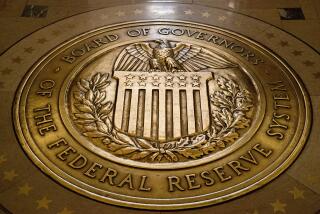Regulators Differ Over Bank, S&L; Capital Rule
- Share via
WASHINGTON — Key federal financial regulators clashed Wednesday over the amount of capital needed to keep banks and savings and loan associations out of fiscal trouble.
Federal Deposit Insurance Corp. Chairman L. William Seidman, who oversees state-chartered banks and the rescue of insolvent S&Ls;, wants a capital reserve equal to 6% of the loans provided by the institutions. But Comptroller of the Currency Robert L. Clarke, responsible for national banks, told a Senate hearing that a 3% standard would be adequate.
“It’s sad we have been unable to agree after many difficult discussions,” Seidman told the Senate Banking Committee. “If we cannot agree . . . Congress will have to get in and decide for us.”
The Federal Reserve Board hasn’t made a choice between the two capital numbers or decided whether to devise its own rule, Vice Chairman Manuel F. Johnson said, adding that he thinks there should be a “common standard.” About 1,000 of the Fed’s 6,200 member banks would be governed by the standard set by the Fed.
The inability to agree on a uniform rule raises the possibility of a splintered approach, with each financial regulator setting a different rule for the safety of financial institutions.
The regulators all accept the need for more intensive oversight of banks and S&Ls; to catch problems before they develop into the kind of massive losses and scandals that plagued the S&L; industry during the past few years. But they can’t find a common ground for deciding on the capital--consisting of cash, securities and other holdings--that provides the financial foundation for the institutions.
Capital is a protection against inept and inefficient management, a safeguard to keep the bank or S&L; operating during a business slump.
The major clash is between Seidman, who has authority to set standards for 8,000 banks, and Clarke, the overseer for about 5,000 banks.
Seidman wears two hats, handling federal insurance and oversight of state-chartered banks as chairman of the FDIC, and planning the disposition of hundreds of defunct S&Ls; as chairman of the Resolution Trust Corp. He is determined to build a cushion of capital at banks and S&Ls; to minimize the potential losses to the federal insurance funds that guarantee deposits up to $100,000.
“Our position is very simple . . . standards to put more capital between us and losses,” he said. “We’re talking about a minimum for those who don’t behave the way we’d like them to,” Seidman said.
Seidman said the standard proposed by Comptroller Clarke, if applied throughout the financial industry, would allow 9,844 banks to reduce their capital by a total of at least $8 billion from current levels.
“Now is not the time to be reducing capital standards,” Seidman said.
Clarke said Seidman’s criticism is “very misleading” and insisted that banks “are not going to lower capital ratios.” Most banks “want to operate at higher levels of capital,” he said.
The 3% standard is sufficient, Clarke said, because it will require banks at greatest risk to raise billions of dollars in additional capital.
Johnson of the Fed said his agency “has not made a final decision on where it stands on this issue. We’re going to have to resolve it; we feel there should be a common standard.”
The issue is whether banks should be forced to go from a 3% capital reserve to 6%, he noted. “Most of the banks caught between 3% and 6% are problem institutions,” Johnson said.
The General Accounting Office provided support for Seidman’s advocacy of a 6% capital standard. “In the final analysis, adequate capitalization is the first line of defense of any financial institution,” Harry Havens, assistant comptroller general, told the committee. “Any proposal that could yield a reduction in that capitalization should be viewed with great caution.”
Although split on the issue of capital standards, the regulators were in general agreement that the health of the banking industry is improving, but is far from robust.
More to Read
Inside the business of entertainment
The Wide Shot brings you news, analysis and insights on everything from streaming wars to production — and what it all means for the future.
You may occasionally receive promotional content from the Los Angeles Times.










